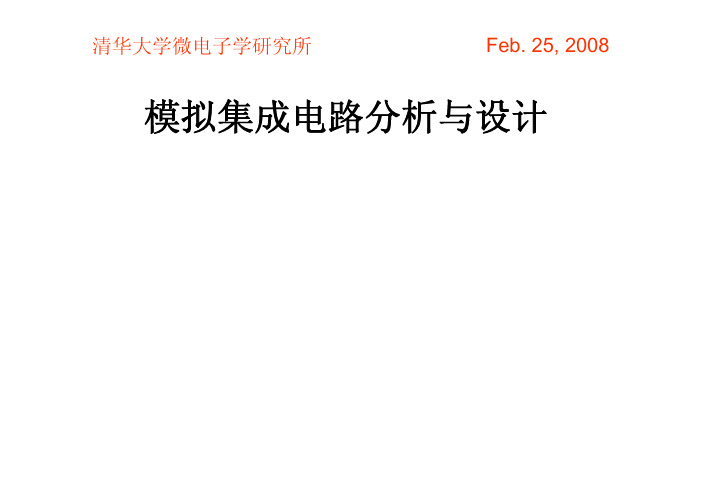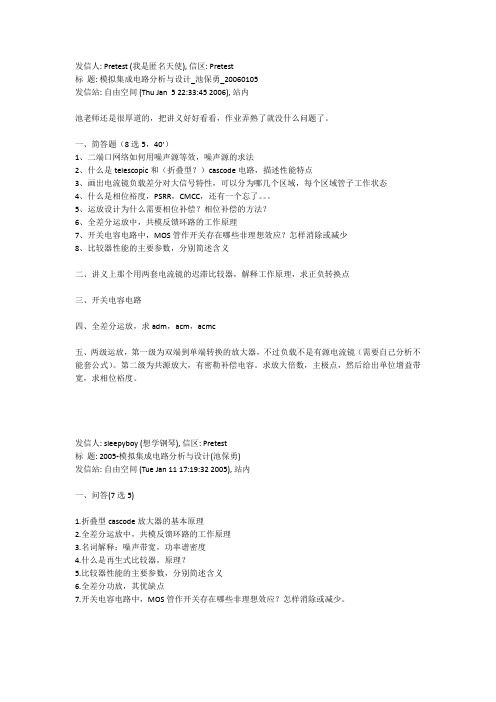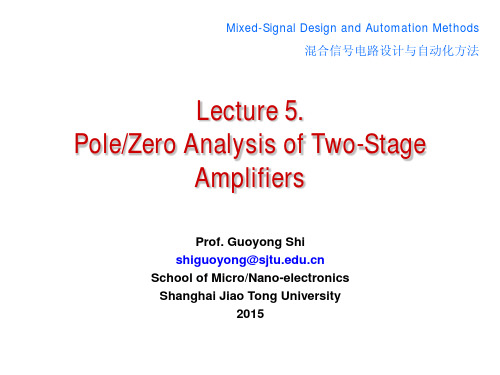Two-stage_design_example_清华大学模拟集成电路分析与设计
清华大学微电子所 数字集成系统 第四讲

混合使用硬件描述语言、卡诺图、状态电路设计覆盖了系统级的算法描述直至综合使用各种方法设计微代码式控制电
在使用本节讨论的电路设计方法之前,电路设计者必须对设计指标要求仔细分
电路的输出完全由电路当前的输入信号可以用组合逻辑实现电路,并不意味着有可能对同一个电路既可以用组合逻辑
对于对于对于对于
硬件设计过程的一步变量个数较少时,设计变量个数较多时
实例:二进制比较器
根据真值表就可以直接得到组合逻辑电把真值表中所有乘积项相加,就可以完电路可能非常不经济。
在变量个数不大
对
实例:串
状态转换图直观地给出了状态之间的转状态转换表则采用表格的方式列出了状
状态
状态
状态
状态
状态
状态转换图中离开一个节点的所有支路例:状态。
课程介绍-清华大学模拟集成电路分析与设计

清华大学微电子学研究所Feb. 25, 2008模拟集成电路分析与设计课程概况z微电子学专业核心课程之一z3学分48学时:每周3学时X16周z目标:培养学生具有初步的模拟集成电路分析能力和设计能力,了解模拟集成电路基本模块的分析方法和设计过程z上课时间:每周一上午第二大节(9:50~12:15)z上课地点:六教6A301z习题课:四次习题课习题课z答疑时间:周三下午2:00~3:30z答疑地点:任课教师办公室答疑地点教材与参考书z教材:Behzad Razavi,“Design of Analog CMOSIntegrated Circuits”, 西安电子科技大学出版社英版中版(英文影印版或者中文版),2001年池保勇,“模拟集成电路分析与设计”,(编写中)z参考书:P R Gray“Analysis and Design of AnalogP.R. Gray, Analysis and Design of AnalogIntegrated Circuits”, Fourth Edition,高等教育出版社英文影印版或者中文版,2001年()P.E. Allen, “CMOS Analog Circuit Design”,Second Edition, 电子工业出版社,2002年,课程内容CMOS电路为主,适当介绍Bipolar电路考核z总原则:学到东西、相对公平总原则学到东西相对公平z平时表现(5%)+作业(10%)+课程设计(25%)+期中考试(开卷,25%)+期末考试(闭卷,35%)试(闭卷z作业:10次作业,每次1分z课程设计:设计思路和结果、口头报告及文档z期中考试:开卷考试(Lecture 1-7)期中考试(Lecture17)z期末考试:闭卷考试(期中考试后的内容)课程设计z课程设计全差分运算放大器的设计(第十四周前递交中期进展报告、第十六周前完成全部电路设计)z三人为一组,根据项目水平以及各人贡献给分人为组,根据项目水平以及各人贡献给分z时间:课后完成,16周习题课上作口头报告(5分钟),期末考试后提交完整书面设计报告z提供的资源:SUE安装文件和帮助文档(画电路图)、Hspice安装文件、Hspice完整的帮助文档、Hspice的简单帮助文档(中文)、仿真工艺库文件、库文件使用说明、课程设计说明文件Hspice ToolBox明文件、Hspice ToolBox(与Matlab的接口文件)及部分数据后处理源文件模拟集成电路概要(1)信号分类(2)集成电路与分立电路(3)模拟集成电路分析与设计(4)模拟集成电路在系统中的作用(5)模拟电路中的基本概念(6)放大器基础模拟信号与数字信号集成电路与分立电路SUN华硕P5K-E/WIFI-AP主板P5K E/WIFI AP集成电路与分立电路模拟集成电路概要(1)信号分类(2)集成电路与分立电路(3)模拟集成电路分析与设计(4)模拟集成电路在系统中的作用(5)模拟电路中的基本概念(6)放大器基础模拟电路分析与设计z电路分析:已知电路拓扑结构和元器件尺寸的基础上应用简单、但足器件尺寸的基础上应用简单但足够精确的元器件模型来分析该电路所具有的各种性能z电路设计:根据一组给定的性能指标设计出满足指标要求的路拓标,设计出满足指标要求的电路拓扑结构并确定各种元器件的尺寸z电路分析是电路设计的前提和基础电路分析可以帮助设计者增强电路知识,了解各种拓扑结构的优势和缺点,为设计者选择合适的电路结构提供参考电路分析是进行电路设计的前提,只有对电路进行了全面的分析,设计者才能明确如何在各种设计指标之间进行权衡,明确如何在各种设计指标之间进行权衡从而确定各元器件的尺寸模拟电路的基本分析方法z基尔霍夫电压定理:任何个电路环路上基尔霍夫电压定理:任何一个电路环路上的各元器件电压降之和等于0模拟电路的基本分析方法(续)z基尔霍夫电流定理:在电路中流进某个节点各支路等点的各支路电流之和等于0模拟电路的基本分析方法(续)z欧姆定理:电阻上的压降等于电流乘以该电阻的阻值欧姆定理电阻上的压降等于电流乘以该电阻的阻值模拟电路的基本分析方法(续)z戴维营诺顿电源等效定理:如果个网络不包含非线性戴维营-诺顿电源等效定理:如果一个网络不包含非线性受控源和非线性元件,则向该网络的输出端口看过去,网络的行为都可以等效为一个电压源和一个阻抗的串联,也可以等效为该阻抗和一个电流源的并联,该阻抗等于向该网络输出端看过去的输出阻抗,电压源等于该端口上的开路电压,而电流源的大小等于该端口的短路电流路电压而电流源的大小等于该端口的短路电流模拟电路的基本分析方法(续)z电路分析基本步骤析本步确定电路的直流工作点确定各元器件的小信号模型及其中的参数值画小信号等效电路(在这一步中,要注意交流与画小信号等效电路(在这步中要注意交流与直流的划分,直流偏置点都是交流地)应用KVL、KCL定理和欧姆定理列电路方程求解方程组得到该电路的分析结果(在这一步中通常要做简化处理)模拟电路的基本分析方法(续)z上述求解过程可能会很复杂,得到的结果可能不能揭示结果能不能揭示电路的本质特征z在课程的学习中,在课程的学习中需要培养对模拟电路的直观分析能力,只有这样,在分析较复杂电路时,才能抓住电路的主要特征,简化分析过程,而且可以更好程而且可以更好的理解电路并用以指导电路的具体设计过程模拟集成电路的设计流程模拟集成电路设计的难点z数字电路:离散信号;模拟电路:连续信号数字电路离散信号模拟电路数字电路速度与功耗;模拟电路速度z数字电路:模拟电路:速度、功耗、增益、精度、线性度、电源电压等z模拟电路对噪声、串绕、其它干扰等更敏感z模拟电路受到元器件二阶效应的影响z EDA工具支持力度不如数字电路z模拟电路的建模与仿真存在困难z现代工艺针对数字电路优化模拟集成电路设计是一门艺术,优秀的模拟电路设计工程师是一个艺术家模拟集成电路概要(1)信号分类(2)集成电路与分立电路(3)模拟集成电路分析与设计(4)模拟集成电路在系统中的作用(5)模拟电路中的基本概念(6)放大器基础自然信号处理z声音信号、图像信号、生物信号、地震信号等z特点:动态范围大,带外干扰强数字通信数字信号恢复多级信号处理¾级数与带宽磁盘驱动器头读取制信转化为信号 磁头读取二进制信息,转化为电信号 含有强噪声成分与失真无线收发机z无线接收机微弱信号、强干扰、高频微弱信号强干扰高频z无线发射机输出强信号、高频光纤通信z高速、宽带信号(10-40Gbps)传感器z传感器各种传感器感知外界信号加速度计高速数字设计z微处理器与存储器、高速数字设计时钟分布与重定时互连线延迟、封装寄生、衬底耦合存储器中的灵敏放大器z高速数字设计本质上就是模拟设计分频器/计数器⋅K+=NPS模拟集成电路概要(1)信号分类(2)集成电路与分立电路(3)模拟集成电路分析与设计(4)模拟集成电路在系统中的作用(5)模拟电路中的基本概念(6)放大器基础直流信号z直流信号:不随时间变化的信号电路中任何一个节点的信号如果不随时间变化,均可认为是直流信号直流分析就是确定电路中各节点的直流信号大小的过程,该过程通常也被称为确定电路的直流(或静态)工作点交流信号z交流信号:随时间变化的信号电路中任何个节点的信号如果随时间会发生变化,则该电路中任何一个节点的信号如果随时间会发生变化,则该信号中必定包含有交流信号成分交流分析是用不同频率的正弦型信号(平均值为0)激励电路,确定电路中各节点对不同频率激励信号所发生的响应的过程由于任何一个交流信号均可等效为不同幅度、不同频率正弦型信号的加权求和,因此模拟电路中通常说的交流信号指的就是平均值为0的正弦型信号一旦采用交流分析方法确定了电路对不同频率正弦型信号的响应,采用叠加定理就可以确定该电路对不同波形信号的响应电路节点信号分析z电路中任何个节点的信号等于该节点的电路中任何一个节点的信号等于该节点的直流信号与该节点的交流信号之和z先采用直流分析方法确定电路中各节点的直流信号(直流工作点),在这一步中假设所有的交流激励信号源均等于0z再采用交流分析方法来得到电路中各节点的交流信号,在这一步中假设所有的直流将两次分析的结果加激励信号源均等于0,将两次分析的结果加在一起,就是该节点的总信号小信号分析z小信号分析:当各节点的交流信号幅度足够小,对电路直流工作点的扰动影响近似可以忽略时可以采用的一种分析方法z大信号分析:当各节点的交流信号幅度很大,对电路直流工作点的扰动影响不可忽略时要采用的分析方法a是一个只与电路的静态工作点相关的参数,它是电路传输曲线在静态工作点Q处的斜率静斜率知道了电路的静态工作点信息,就可以确定a的大小在静态工作点周围,电路的输出信号与输入信号之间的关系就由a唯一确定,这样给电路分析和设计带来很大方便小信号分析与大信号分析z小信号分析是一种线性化的分析方法它把电路的传输特性在静态工作点进行线性化,并用来描述电路在静它把电路的传输特性在静态工作点进行线性化并用来描述电路在静态工作点一定范围内的行为,在这一小段范围内,输出信号与输入信号之间成线性关系该线性化范围的大小与对电路线性度的要求有关。
Chap3_a_清华大学模拟集成电路分析与设计

第三章 单管放大器的分析与设计本章首先以电阻作负载的共源放大器为例,讨论了对电路进行大信号分析与低频小信号分析的方法,说明了大信号分析与小信号分析的区别与联系,并详细介绍了频率响应的近似分析方法和噪声分析方法;在以上介绍的基础上,详细讨论了基于G m /I D 设计流程的共源放大器的设计流程,该设计流程能指导设计工程师快速地进行初始设计,对模拟电路的设计具有很重要的指导意义;然后我们讨论了其它的单管放大器结构,包括有源负载共源放大器、源简并共源放大器、共栅放大器和源极跟随器,重点讨论了每种单管放大器的基本特性(包括大信号特性、小信号特性或频率特性)。
通过本章的介绍,读者可以掌握基本的模拟电路分析方法,能够对简单电路的大信号特性、小信号特性、频率特性和噪声特性进行分析,并了解各种单管放大器的基本特点。
本章所介绍的G m /I D 设计流程是一种较好的模拟集成电路设计流程,通过本章的介绍,读者可以基本了解基于G m /I D 流程的设计方法,可以进行简单的单管放大器集成电路的设计。
3.1 电阻做负载的共源放大器图3-1给出了一个电阻作负载的共源放大器的电路图。
输入电压信号V i 输入到MOS 管的栅极,经MOS 管转化为漏端的电流信号I d ,该电流流过负载电阻R D 后在电阻上产生一个压降,输出电压信号从MOS 管的漏端取出,其值为:o DD d D V =V -I R (3.1)当输入电压信号V i 变化时,I d 跟着变化,导致输出电压V o 发生变化,完成放大功能。
下面我们来分析这个简单电路的大信号特性和小信号特性。
图 3-1电阻作负载的共源放大器的电路图 3.1.1共源放大器的大信号分析图3-1所示的电阻作负载的共源放大器,它的大信号转移曲线(即输出电压与输入电压的关系曲线)如图3-2所示。
输入电压V i 从零开始增加,只要输入电压V i 小于晶体管的阈值电自编教材试行本勿扩散压V t ,MOS 管就工作于截止区,流过晶体管漏端的电流为0,输出电压V o 等于电源电压V DD ,即i t o DD V V V V <⇒= (3.2)图3-2 共源放大器的大信号转移曲线当输入电压V i 增加到大于MOS 管的阈值电压V t 时,MOS 管开始导通,有电流流过负载电阻R D ,导致输出电压V o 开始下降。
Virtuoso cadence教程 清华大学

Cadence最精华的部分在哪里
Virtuoso Layout Editor
界 面 漂 亮 友 好
26
操 作 方 便 高 效
功 能 强 大 完 备
版图设计工具-Virtuoso LE
CADENCE
目标
理解 Layout Editor 环境 学会如何使用 Layout Editor
学会运行交互 DRC&LVS
CADENCE
7
61
绘制反相器版图
CADENCE
8
62
绘制反相器版图
CADENCE
9
63
Virtuoso Layout Editor
CADENCE
现在,您已经掌握版图编辑大师的基本 操作,通过上机实验巩固和提高!
64
CADENCE
Cadence设计系统介绍
清华大学微电子所
65
OUTLINE
CADENCE
Cadence 系统概述 版图设计工具-Virtuoso LE 版图验证工具-Diva 版图验证工具-Dracula
6 显示文件(display.drf)
18
系统启动
CADENCE
系统启动 1 前端启动命令 命令 icde
icds icms icca
规模 s
s m xl
19
功能
基本数字模拟设 计输入
icde 加数字设计 环境 前端模拟、混合、 微波设计
前端设计加布局 规划
系统启动
CADENCE
2 版图工具启动命令 命令 规模 功能
Stage 4:
P+ implant
49
N+ implant
绘制反相器版图
期末清华大学模拟集成电路池保勇考题

发信人: Pretest (我是匿名天使), 信区: Pretest标题: 模拟集成电路分析与设计_池保勇_20060105发信站: 自由空间 (Thu Jan 5 22:33:45 2006), 站内池老师还是很厚道的,把讲义好好看看,作业弄熟了就没什么问题了。
一、简答题(8选5,40')1、二端口网络如何用噪声源等效,噪声源的求法2、什么是telescopic和(折叠型?)cascode电路,描述性能特点3、画出电流镜负载差分对大信号特性,可以分为哪几个区域,每个区域管子工作状态4、什么是相位裕度,PSRR,CMCC,还有一个忘了。
5、运放设计为什么需要相位补偿?相位补偿的方法?6、全差分运放中,共模反馈环路的工作原理7、开关电容电路中,MOS管作开关存在哪些非理想效应?怎样消除或减少8、比较器性能的主要参数,分别简述含义二、讲义上那个用两套电流镜的迟滞比较器,解释工作原理,求正负转换点三、开关电容电路四、全差分运放,求adm,acm,acmc五、两级运放,第一级为双端到单端转换的放大器,不过负载不是有源电流镜(需要自己分析不能套公式)。
第二级为共源放大,有密勒补偿电容。
求放大倍数,主极点,然后给出单位增益带宽,求相位裕度。
发信人: sleepyboy (想学钢琴), 信区: Pretest标题: 2005-模拟集成电路分析与设计(池保勇)发信站: 自由空间 (Tue Jan 11 17:19:32 2005), 站内一、问答(7选5)1.折叠型cascode放大器的基本原理2.全差分运放中,共模反馈环路的工作原理3.名词解释:噪声带宽,功率谱密度4.什么是再生式比较器,原理?5.比较器性能的主要参数,分别简述含义6.全差分功放,其优缺点7.开关电容电路中,MOS管作开关存在哪些非理想效应?怎样消除或减少。
二、给出一个放大器电路,求静态工作点,等效噪声系数三、迟滞性比较器,求正、负向转换点,画电压输入输出曲线四、2相非重叠时钟开关电容电路,和课件上的例题基本一样五、全差分运放,求低频下的共、差模增益2小时的考试时间延了半个小时(比期中延得少多了。
集成电路设计自动化 讲义 Lect05_Two_Stage_PZ_Analysis(update)

GBW
ωT
log10 (ω)
0°
−45° −90°
−135° compensated
−180°
2015-09-05
uncompensated
Lecture 5
phase margin
log10 (ω)
slide 20
Gain-Bandwidth Product (GBW)
D(s) = 1 + s[RII (CII + CC ) + RI (CI + CC ) + RI RII gmIICC ] + s2RI RII [CICII + CC (CI + CII )]
-1/p1
(Dominating term)
1/p1p2
p1
= −1 / [RII (CII
+ CC ) +
Mixed-Signal Design and Automation Methods 混合信号电路设计与自动化方法
Lecture 5. Pole/Zero Analysis of Two-Stage
Amplifiers
Prof. Guoyong Shi shiguoyong@ School of Micro/Nano-electronics Shanghai Jiao Tong University
2015
Outline
• Small-signal MOS models • Two-stage opamp small-signal model • Two-pole analysis • Deriving poles and zeros by DPI • Frequency compensation • Design for phase margin • Pole/zero intuitions • Design strategies for zero
模拟电子电路模电课件清华大学华成英4集成运算放大电路

注意集成运算放大器的散热问题,采取适当的散热措施,避免过热导致性能下降或损坏。
在电路设计时考虑噪声干扰的影响,采取措施减小噪声干扰,如使用屏蔽、远离噪声源等。
在使用过程中注意避免突然的电压或电流冲击,以免造成集成运算放大器的损坏。
谢谢
THANKS
详细描述
共模抑制比是集成运算放大器性能的重要指标之一,它影响着电路的稳定性和性能。
总结词
在实际应用中,电路中的干扰和噪声通常是共模的,因此共模抑制比的大小直接影响到电路的性能和稳定性。在选择集成运算放大器时,需要根据实际需求来选择具有较大共模抑制比的型号。
详细描述
集成运算放大器的使用注意事项
了解集成运算放大器的规格书,确保其满足电路的性能要求。
良好的线性度
集成运放的内部电路设计使得它在放大信号时产生的噪声较低。
低噪声
集成运放的输入阻抗一般都在兆欧姆级别,使得它对信号源的影响较小。
高输入阻抗
按功能
可以分为通用型和专用型两类。通用型集成运放适用于多种场合,而专用型集成运放则是针对特定应用设计的,如仪表放大器、音频放大器等。
按性能指标
可以分为低噪声、高精度、高速型等不同类型。低噪声型集成运放主要用于信号放大,高精度型用于高精度的测量和运算,高速型则用于高速信号处理和传输。
电压-频率转换
电压-电流转换
集成运算放大器的性能指标
详细描述
开环电压增益的数值越大,意味着对微弱信号的放大能力越强,因此开环电压增益是衡量集成运算放大器性能的重要参数之一。
总结词
开环电压增益是衡量集成运算放大器放大能力的重要指标。
详细描述
开环电压增益是指在无反馈情况下,输入信号经过集成运算放大器放大后的输出电压与输入电压的比值。这个比值越大,说明放大器的放大能力越强。
模拟集成电路中的基本元器件-清华大学模拟集成电路分析与设计

模拟集成电路中的基本元器件提要z MOS管概述、基本工作原理、大信号特性、管概本作大信特性电容特性小信号等效模型非想效应电容特性、小信号等效模型、非理想效应、描述MOS管性能的电路参数z双极晶体管的大信号特性、小信号等效模双极晶体管的大信号特性小信号等效模型z集成电阻器z集成电容器MOS 管概述、基本工作原理、大信号特性电容特性小信号等效模型z B.Razavi,“Design of Analog CMOS 性、电容特性、小信号等效模型,g g Integrated Circuits”,§2.1、§2.2、§2.4MOS管概述耗尽型器件NMOS:B接V SSPMOS:B接V DDMOS管概述MOS管的基本工作原理MOS管的基本工作原理(续)MOS管的基本工作原理(续)MOS管的基本工作原理(续)MOS管的大信号特性MOS管的电容效应CWLMOS管的电容效应MOS管的常用小信号模型(饱和区)MOS管的完整小信号模型MOS管的非理想效应y,y gz P.R.Gray,“Analysis and Design of Analog Integrated Circuits”,§1.7、§1.8v E c≈MOS 管的电压限制z pn 结击穿:漏-衬底pn 结由于雪崩效应而击穿,非破坏性z 源漏穿通:源漏极的耗尽区相连,电流逐渐增加,非破坏性z 热载流子:由于水平或垂直电场的作用,热载流子获得足够的速度注入氧化层增加栅电流改变阈获得足够的速度注入氧化层,增加栅电流,改变阈值电压,破坏性氧化层击穿z 氧化层击穿:垂直场,破坏性,ESD 保护cm V cm V /107~/10666××描述OS管性能的电路参数MOS结果说明MOS 晶体管的特征频率11()i gs gd v i C C s=+m T g C ω=1m g =v g i ≈C +2T f C C π+()()()j j i j C C j βωωωω===+i gs gd特征频率仿真结果说明道2z 长沟道、饱和区:m o ov g r V λ=结果说明描述MOS管性能的电路参数提要z MOS管概述、基本工作原理、大信号特性、管概本作大信特性电容特性小信号等效模型非想效应电容特性、小信号等效模型、非理想效应、描述MOS管性能的电路参数z双极晶体管的大信号特性、小信号等效模型双极晶体管的大信号特性小信号等效模型z集成电阻器z集成电容器P.R. Gray, “Analysis andDesign of Analog IntegratedD i f A l I t t dCircuits”, §1.3、§1.4双极晶体管概述βnpn 管的Early 效应I CEC C V I ∂/npn 管在饱和区的大信号模型=)(on BE BE V V )3.0~05.0(~)(V V V V V V V sat CE BC BE BE CB CE =−=+=V BE双极晶体管的寄生效应集成pnp管z水平pnp管:电流增益低,电流增益随集电极电流的升而很快下降处电流能力弱电流的上升而很快下降,处理电流能力弱集成pnp管z衬底pnp管:仅限于源跟随器配置,集电极寄生电阻大')1()('2DS t GS D k V V V W k I λ=+−=22LBJT与MOS管的异同:小信号模型rπ→∞器件模型的选择z手工分析和设计的目的:直观理解电路特性,设计过手工分析和设计的目的直观理解电路特性设计过程的初始化z总原则:在保证分析结果抓住电路主要特性的前提下,器件模型越简单越好,允许手工分析结果具有10-20%的偏差z静态工作点分析(一般情况下)初始分析可以忽略沟道长度调制效应和衬偏调制效应(Early效应),了解基本特性后再考虑这些二阶效应的影响E l效应)z小信号分析(一般情况下))除非晶体管漏端(集电极)所接阻抗足够高(>100kΩ),初始分析可以忽略晶体管输出阻抗ro。
- 1、下载文档前请自行甄别文档内容的完整性,平台不提供额外的编辑、内容补充、找答案等附加服务。
- 2、"仅部分预览"的文档,不可在线预览部分如存在完整性等问题,可反馈申请退款(可完整预览的文档不适用该条件!)。
- 3、如文档侵犯您的权益,请联系客服反馈,我们会尽快为您处理(人工客服工作时间:9:00-18:30)。
scalegm1 :=
fc
fcaccurate
scalegm1 = 1.134
scalePM := PM − PMaccurate scalePM = 3.08 deg
Re-calculate transconductances
gm1 :=
1 β
⋅2⋅π
⋅fc⋅Cc⋅
scalegm1
k
:=
tan⎛⎜⎝π⋅
⎞ ⎠
⋅⎛⎜ ⎝
1
−
s p2
⎞⋅ ⎠
⎛⎜1 ⎝
−
s⎞ p3 ⎠
( ( )) PMaccurate := 180deg + arg T j⋅2⋅π⋅fc
fx := fc Given
( ) T j⋅2⋅π⋅fx = 1
( ) fcaccurate := Find fx
PMaccurate = 69.92 deg fcaccurate = 132.289 MHz
Cc
+
2⋅β)
Calculate compensation capacitor
Cc
:=
2⋅2
1 β
⋅
kB⋅Tr ⋅γ⋅(1
Ntot
+
2⋅β)
Cc = 488.831 fF
Static error spec:
avo :=
1 ε s⋅ β
avo = 724
β⋅avo = 200
For simplicity, assume that each stage contributes same gain, and that each device M1...M4 is designed for same intrinsic gain. Intrinsic gain in each device is must then be larger than
Normalize all caps, so that optimization engine does not need to deal with extremely small quantities (this seems to be an issue in MathCAD)
Cnorm := 1fF
ID2 :=
gm2 gmID2
gmID1 =
5.089
1 V
gmID2 =
1 10.813
V
ID1 = 371.585 µA ID2 = 530.233 µA
ID1 + ID2 = 901.818 µA
Current densities and device widths (using look-up table)
( ) ( ) IDW1 := pidw L1 , gmID1
IDW2 := nidw L2 , gmID2
IDW1
=
6.017
A m
IDW2
=
5.054
A m
W1 :=
ID1 IDW1
W2 :=
ID2 IDW2
W1 = 47.188 µm W2 = 72.126 µm
Refinement
We could now simulate this design in Spice and resolve discrepancies (due to approximations) through a few iterations and "educated tweaking". Alternatively, it is possible to improve the design accuracy by performing one more corrective iteration using more accurate equations:
ID1 :=
gm1 gmID1
ID2 :=
gm2 gmID2
gmID1
=
5.874
1 V
gmID2
=
12.75
1 V
ID1 = 283.936 µA ID2 = 364.529 µA
ID1 + ID2 = 648.465 µA
Current densities and device widths (using look-up table)
Noise requirement
Approximate noise equation (assumes gm2>>gm1, and gm(load) = gm(active).
Ntot :=
0.5⋅Vodmax2 DR
10 10
Ntot = 355.234 µV
Ntot
=
2⋅2
1 β
⋅
kB⋅Tr ⋅γ⋅(1
Cj1 := (1 + 0.5)⋅0.8Cgg1 Cj2 := (1 + 1)⋅0.8Cgg2 C1 := Cj1 + Cgg2
C2 := CL + Cj2 + (1 − β)⋅Cf
Cj1 = 148.8 fF Cj2 = 222.72 fF C1 = 288 fF C2 = 767.471 fF
Total stage 1 load Total stage 2 load
fT1 = 2.427 GHz fT2 = 6.555 GHz
gm/ID to meet fT values above (using look-up table)
( ) ( ) gmID1 := pgmid L1 , fT1 gmID2 := ngmid L2 , fT2
ID1 :=
gm1 gmID1
⋅γ⋅(1
+
2⋅β)⋅
1 Cnorm
gm1
←
1.15
1 β
⋅2⋅π⋅fc⋅Cc⋅Cnorm
Cj1 ← (1 + 0.5)⋅0.8Cgg1
Cj2 ← (1 + 1)⋅0.8Cgg2
CLtot ← CL + Cj2 + (1 − β)⋅Cf
k
←
tan⎛⎜⎝π⋅
PM + 3deg 180deg
⎞ ⎠
( ) gm2
( ) ( ) IDW1 := pidw L1 , gmID1
IDW2 := nidw L2 , gmID2
IDW1
=
7.876
A m
W1 :=
ID1 IDW1
W2 :=
ID2 IDW2
W1 = 47.18 µm
IDW2
=
7.416
A m
W2 = 71.497 µm
Find best design choice using optimization function
Cgg1 := 0.31⋅Cs DESIGN CHOICE 1: Cgg usually comparable to Cs
Return factor
β :=
Cf
Cf + Cs + Cgg1
β = 0.276
Hale Waihona Puke Cgg2 := 0.348⋅CL DESIGN CHOICE 2: Cgg2 usually comparable to CL
←
⎡ k⋅2⋅π⋅fc⋅⎢
CLtot⋅
⎣
Cgg2 Cc
+
Cj1
⎤ + Cgg2 + Cj1 + CLtot⎥⋅Cnorm
⎦
fT1
←
1 ⋅ gm1 2⋅π Cgg1⋅Cnorm
fT2
←
1 ⋅ gm2 2⋅π Cgg2⋅Cnorm
( ) ( ) gmID1 ← if ⎛⎜⎝pgmid L1 , fT1
>
fT1 :=
1 ⋅ gm1 2⋅π Cgg1
fT2 :=
1 ⋅ gm2 2⋅π Cgg2
fT1 = 2.141 GHz fT2 = 5.314 GHz
gm/ID to meet fT values above (using look-up table)
( ) ( ) gmID1 := pgmid L1 , fT1 gmID2 := ngmid L2 , fT2
2-Stage OTA Design Example (Small-Signal)
Cf
Cs
+
Vsd
Vid
-
Cs
Cf
Given parameters and specs
Cs := 400fF fc := 150MHz
Cf := 200fF PM := 73deg
CL := 400fF εs := 0.5%
Given Cgg1 > 0
Cgg2 > 0
( ) Copt := Minimize f, Cgg1 , Cgg2
Copt
=
⎛⎜⎝
123.885 139.245
⎞ ⎠
f⎛⎝Copt0, Copt1⎞⎠ = 907.545 µA
Junction capacitance estimates at 1st/2nd stage output. Cj is approximately equal to Cgg. Assume Stage 1 loads (NMOS) are half as wide as diff pair devices (PMOS); assume 2nd stage loads (PMOS) have same width as CS devices (NMOS)
Estimate transconductances
gm1 :=
1 β
